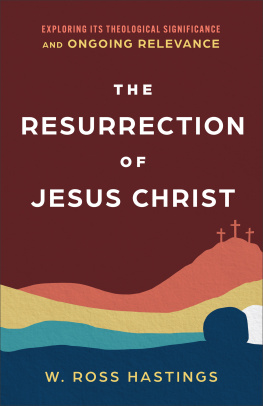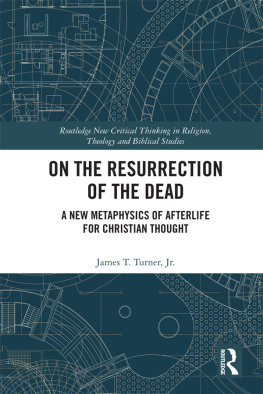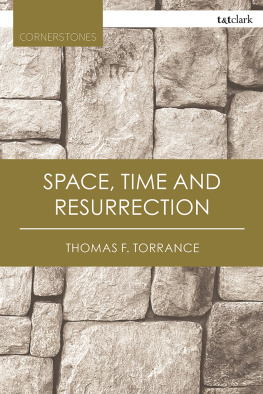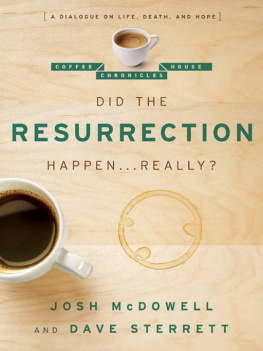Sommaire
Pagination de l'dition papier
Guide
THE HOPE OF LIFE
AFTER DEATH
A Biblical Theology
of Resurrection
M. JEFF BRANNON
 InterVarsity Press
InterVarsity Press
P.O. Box 1400 | Downers Grove, IL 60515-1426
2022 by Michael Jeffrey Brannon
All rights reserved. No part of this book may be reproduced in any form without written permission from InterVarsity Press.
InterVarsity Press is the publishing division of InterVarsity Christian Fellowship/USA. For more
information, visit intervarsity.org.
All Scripture quotations, unless otherwise indicated, are taken from The Holy Bible, New International Version, NIV. Copyright 1973, 1978, 1984, 2011 by Biblica, Inc. Used by permission of Zondervan. All rights reserved worldwide. www.zondervan.com. The NIV and New International Version are trademarks registered in the United States Patent and Trademark Office by Biblica, Inc.
The Runner, copyright Alex J. MacDonald 2008, used with permission.
www.alexjmacdonald.co.uk/CD%20Lyrics.pdf.
The publisher cannot verify the accuracy or functionality of website URLs used in this book beyond the date of publication.
Cover design and image composite: David Fassett
ISBN 978-0-8308-5532-2 (digital)
ISBN 978-0-8308-5531-5 (print)
This digital document has been produced by Nord Compo.
For Colin, Drew, Evan, and Kate.
May you know and live in light of the hope of resurrection.
SERIES PREFACE
BENJAMIN L. GLADD
THE ESSENTIAL STUDIES IN BIBLICAL THEOLOGY is patterned after the highly esteemed series New Studies in Biblical Theology, edited by D. A. Carson. Like the NSBT, this series is devoted to unpacking the various strands of biblical theology. The field of biblical theology has grown exponentially in recent years, showing no sign of abating. At the heart of biblical theology is the unfolding nature of Gods plan of redemption as set forth in the Bible.
With an influx of so many books on biblical theology, why generate yet another series? A few reasons. The ESBT is dedicated to the fundamental or essential broad themes of the grand story line of the Bible. Stated succinctly, the goal of the ESBT series is to explore the central biblical-theological themes of the Bible. Several existing series on biblical theology are generally open-ended, whereas the ESBT will be limited to ten or so volumes. By restricting the entire series, the scope of the project is established from the beginning. The ESBT project functions as a whole in that each theme is intentional, and each volume does not stand solely on its own merits. The individual volumes interlock with one another and, taken together, form a complete and cohesive unit.
Another unique dimension of the series is a robust emphasis on biblical theology, spanning the entire sweep of the history of redemption. Each volume traces a particular theme throughout the Bible, from Genesis 13 to Revelation 2122, and is organically connected to the person of Christ and the church in the New Testament. To avoid a flat biblical theology, these projects are mindful of how the New Testament develops their topics in fresh or unexpected ways. For example, the New Testament sheds new light on the nature of the kingdom and messiah. Though these twin themes are rooted and explored in the Old Testament, both flow through the person of Christ in unique ways. Biblical theology should include how Old Testament themes are held in continuity and discontinuity with the New Testament.
The audience of the series includes beginning students of theology, church leaders, and laypeople. The ESBT is intended to be an accessible introduction to core biblical-theological themes of the Bible. This series is not designed to overturn every biblical-theological rock and investigate the finer details of biblical passages. Each volume is intentionally brief, serving as a primer of sorts that introduces the reader to a particular theme. These works also attempt to apply their respective biblical-theological themes to Christian living, ministry, and worldview. Good biblical theology warms the heart and motivates us to grow in our knowledge and adoration of the triune God.
AUTHORS PREFACE
THIS BOOK REPRESENTS the fruit of my reflection on and investigation of the topic of resurrection. My interest in the topic began when a seminary professor stated that many Christians can articulate the importance of Jesus sacrificial death on the cross but have an impoverished understanding of the importance of Jesus resurrection from the dead. Although I would not begin a formal study of resurrection until many years later, I began to reflect on this topic and the importance of Jesus resurrection from that point.
What began as a reflection on Jesus resurrection led to the study of resurrection in the Old Testament and finally morphed into a biblical theology of resurrection. As I began to study the topic in earnest, I became convinced of a couple of things. First, resurrection is an essential and central doctrine in Scripture. Second, the hope of resurrection is inextricably linked with all other creation and redemption themes and doctrines. What I had previously perceived to be a peripheral doctrine that I was trying to make sense of came into focus as an essential doctrine that is indispensable for Gods plan of redemption. My hope and prayer are that, in reading this book, you will also recognize the centrality and importance of resurrection for discipleship and for the hope we have as Christians.
In line with the other volumes in the ESBT series, my aim in this book is to trace the hope of resurrection throughout Scripture and redemptive historyfrom Genesis 1 to Revelation 22. My goal is that the book would represent serious reflection on how the doctrine of resurrection unfolds in Scripture that pastors and scholars could benefit from, but that it would also be accessible for all Christians to read. By and large, this book represents the fruit of my own study and reflection on Scriptures teaching on resurrection. In various places, I cite, quote, and interact with scholars who have emphasized similar points, but I am in very few places directly dependent on them. In keeping with the goal that the book be widely accessible, unless otherwise stated I have used the New International Version (2011) for Bible quotations and citations.
No book is ever completed in a vacuum, and I am exceedingly appreciative of those who helped bring this volume to fruition. My wife, Jennifer, and son Colin were my first readers and provided feedback and encouragement on the first drafts of my chapters. I am also thankful for friends and colleagues who provided feedback on all or parts of the manuscript. Joe Martin, Holly Carey, O. Palmer Robertson, Richard Pratt, Tom Wilson, and Stephanie Morton all provided invaluable insight for how the book could be improved and sharpened. I am particularly grateful for Ben Gladd, both for his friendship over the past ten years and for his editorial insight for the series and this book. Finally, Anna Gissings editorial feedback helped bring this project to its completion.














 InterVarsity Press
InterVarsity Press